Meta-analysis of Mobile Phone Reminders on HIV Patients’ Retention to Care
Meta-analysis of Mobile Phone Reminders on HIV Patients’ Retention to Care
SoSon Jong, RN, PhD1, Yvette Cuca, PhD1, Lisa M. Thompson, FNP, PhD2
1School of Nursing, University of California, San Francisco; 2School of Nursing, Global Health Sciences, University of California, San Francisco
Corresponding Author: soson.jong@ucsf.edu
Journal MTM 6:1:5–18, 2017
Aims: This research aims to systematically review the current clinical evidence of the efficacy of mobile phone reminders on retention to care among HIV patients. This study also seeks to determine an effect size of the intervention and presents implications for future studies.
Background: Use of mobile technologies is an innovative and affordable approach to HIV prevention and care, particularly in resource limited settings. Approximately two-thirds of people who are initially diagnosed with HIV are lost to follow-up before starting HIV treatment in low and middle-income countries, posing serious global health concerns. While mobile text message reminders for HIV medication adherence have shown positive health outcomes, it is not well understood whether the reminders can also improve patients’ retention to care.
Methods: The authors conducted a meta-analysis of literature in the following databases: PubMed, CINAHL, ProQuest, and Web of Science. Of the 667 peer-reviewed research articles reviewed, nine studies were included in the final analysis. Stata version 13 was used for the analysis.
Results: Nine studies (5 randomized controlled and 4 before and after studies) from 7 countries included 3,004 HIV patients. Random-effect meta-analysis (I-squared=94.1%) found that HIV patients who received mobile phone reminders for their follow-up appointments were two times more likely to return to care than those who didn’t receive reminders (pooled odd ratio (OR)=2.04, 95% CI: 0.97–4.27). Our sub-group analysis of 5 randomized controlled studies showed a significant effect of mobile phone reminders (OR=2.04, 95% CI: 1.11–3.74). Six studies in Africa showed that HIV patients (mostly women) receiving mobile phone reminders were three times more likely to return to care than those who received no reminders (OR=2.92, 95% CI: 1.13–7.53).
Conclusion: Mobile phone reminders are an effective intervention to improve retention to HIV care. Women with HIV living in resource limited settings benefit significantly from the intervention. Also, mobile phone reminders using text messages are as effective as phone calls to improve retention to HIV care.
Introduction
HIV remains a devastating disease and is ranked as the second leading cause of death in low-income countries.1 Worldwide, the adult prevalence of HIV is 0.8%; in Sub-Saharan Africa, the adult prevalence is as high as 16%. Sub-Saharan Africa is the epicenter of the HIV epidemic and is the region most affected by the disease.1 According to the Joint United Nations Programme on HIV/AIDS (UNAIDS), there were approximately 23.5 million people living with HIV in Sub-Saharan Africa. This accounts for 69% of the global HIV burden in 2011. HIV affects women disproportionally compared to men; 58% of those infected by HIV in this region are women.2
Universal access to HIV treatment, specifically anti-retroviral therapy (ART), has improved survival among people living with HIV/AIDS (PLWH). HIV is a condition requiring a lifetime of ART with close management by health care providers. In regions with good ART coverage, HIV has become a manageable chronic disease. One of the challenges in HIV prevention and management has been providing continuity of care, particularly in developing countries where the health care infrastructure is poor. The President’s Emergency Plan for AIDS Relief (PEPFAR) recently reported that up to two-thirds of patients in developing countries may be lost to follow-up after HIV diagnosis and before starting ART.3
Mobile phone technology, with its ubiquitous capability to reach people at a low cost, can benefit health care systems and has become an important method for improving continuity of care for PLWH.4,5 Acknowledging that providing continuity of care for PLWH is critical for HIV-related health outcomes, the purpose of this paper is to systematically review the effectiveness of mobile phone reminders for improving patients’ retention in HIV care.
Patient Retention in HIV Care: Challenges and Consequences
Non-attendance at health care appointments is a significant independent predictor of progression of HIV.6 Non-adherence to medications leads to progression of HIV disease, posing a higher risk of transmitting HIV to others in the community.6,7 Authors of a retrospective cohort study identified that HIV patients with poorer retention to care were more likely to have poorer survival over time, less improvement of CD4 cell counts and less reduction in plasma HIV level than those adhering to HIV care.8 Obviously, people who do not return for periodic appointments are eventually lost to follow-up (LTFU). A meta-analysis reported a retention rate for PLWH in care was 62% in 3 years in the United States.7,9 Gardner et al. estimated that less than 50 percent of PLWH in the United States are actively engaged in HIV care, and only 19% of PLWH have an undetectable HIV viral load.7 The rate of LTFU in treatment programs varies widely based on setting, ranging from five to 40 percent within six months of ART initiation in resource-limited settings.10
Several terms are often used interchangeably to describe patients’ retention to care and provision of continuity of care: missed appointments, non-attendance, and LTFU (lost to follow-up). Chi and the colleagues defined LTFU as ‘patient does not present to medical appointment within 180 days from the last clinic visit’, based on HIV patients attending 111 health facilities in 19 countries.11 In other studies, measuring attendance is defined as returning to care within a certain interval ranging from 3 days to 9 months.12,13 The present literature review acknowledges a wide variation in definition of attendance, and uses the definitions as specified by each author as LTFU.
Reasons for LTFU are multi-factorial, and differ based on ability to access resources. In resource-limited settings, including many African rural areas, lack of transportation and cost of travel have been identified as major barriers to retention to HIV care. In one study from Kenya, participants who had to pay more than US$1.25 for transportation to a clinic were significantly more likely to fail to return for care compared to those paid less than that amount (RR: 1.35, 95% CI 1.15–1.58),13 which is consistent with other study findings about distance from clinic.14 A qualitative study identified substance use and HIV-associated stigma, as two principle reasons for LTFU in Ethiopia.15 The authors of a retrospective cohort study in South Africa identified that death, relocation and transfer to other clinics were reasons for LTFU rather than gender, ethnicity, and age.16
A randomized controlled study in Switzerland conducted in large urban HIV clinics found that younger age, male sex, follow-up appointment greater than 1 year, and substance abuse were significant predictors for LTFU.17 Other patient-related factors are health beliefs, health status, transportation, scheduling, and financial status. Lack of communication between providers and patients, waiting time at clinic, and quality of consultations are additional health care related factors that impact LTFU.18
A review of U.S. studies suggested multiple strategies to improve retention to care of HIV patients, such as facilitating access to care (e.g. transportation services), case management, peer support, and promoting diversity in clinical care (e.g. bilingual/bicultural services).19 A randomized controlled study from Malawi used incentives to encourage people to return to the clinic to receive their HIV test results and even a small incentive doubled the return rates.20
Mobile technologies, an affordable, innovative approach to improving retention to HIV care
Mobile phone subscriptions have almost saturated the globe. With a world population of over 7.2 billion people, there were 6.8 billion mobile subscriptions in 2013. This phenomenon has been reported in several research studies. Three studies from rural Uganda, Kenya and rural Swaziland reported that the proportion of cell-phone ownership among screened participants reached 65 to 75%.13,14,21
Compared to phone calls, which can be relatively costly for low-income subscribers, text messages or short message service (SMS) are more affordable with less interruption of recipients’ daily life. SMS can be stored and accessed later.22 With the fast penetration of mobile phone subscription in developing countries, studies have used mobile technologies to assess a range of health outcomes, such as medication adherence, monitoring chronic health outcomes, and providing psychological support.18 A recent meta-analysis that included 9 intervention studies showed that SMS reminders improved adherence to ART. PLWH who received SMS reminders had significantly higher ART adherence (pooled odd ratio (OR)=1.39; 95% confidence interval (CI)=1.18, 1.64) and lower HIV RNA load (pooled OR=1.56; 95% CI=1.11, 2.20) compared to the control group.23 A Cochrane review of four intervention studies concluded that SMS reminders of general health care appointments showed moderate effectiveness on clinic attendance (pooled risk ratio (RR): 1.10; 95% CI=1.03, 1.17).18
In addition to improved patient health outcomes, mobile technologies assist health care delivery by providing a platform for staff training, disease surveillance, data collection and reporting, and monitoring of drug supply chains.5 This innovative approach has the potential to fill gaps in health care delivery in many developing countries.
Significance of This Paper
Despite the rapidly increasing research on the use of mobile technologies for improved health outcomes, it is not clear whether mobile phone reminders can prevent LTFU and improve retention to care among PLWH. While its effectiveness on adherence to ART is promising, individuals outside of care or LTFU do not benefit from the intervention. Considering that one of the biggest challenges in the provision of HIV care is linkage to care from diagnosis to life-long commitment to ART adherence, understanding mobile phone effectiveness on retention to care is critical. Using a systematic review, meta-analysis approach, we answer the following three research questions: (1) what is the available clinical research evidence on mobile phone reminders for retention to HIV care? (2) what is the effect size of an mobile phone reminders intervention?, and (3) what are the implications of these findings to future studies?
Methods
We followed the Preferred Reporting Items for Systematic Reviews and Meta-Analyses (PRISMA) statement guidelines.24 Two researchers conducted independent literature searches and selected nine studies based on the inclusion criteria. Using these nine studies, we performed sensitivity analyses and an assessment of publication bias.
Search Strategies
The authors conducted an initial literature search using Boolean strategy using the following databases: PubMed, CINAHL, ProQuest, and Web of science. Search terms were ‘HIV AND mobile phone, cellular phone, text message* OR SMS (short message service)’. Databases were searched between March 28 and April 26, 2014 with a second search in November 2015 for possible inclusion of additional studies. There was no restriction based on language or year published although most of the literature was from the last 15 years due to the nature of mobile technology used in health care research. The searches resulted in 1,438 peer-reviewed articles (see Figure 1). The authors independently reviewed the abstracts and screened duplications of the articles using a citation management program (RefWorks/EndNote). Inclusion criteria for the final reviewed papers were: 1) clinical research employing mobile phone reminders to improve retention to care; and 2) inclusion of HIV patients and family member paired with babies exposed to HIV. Study protocols or review articles were excluded.
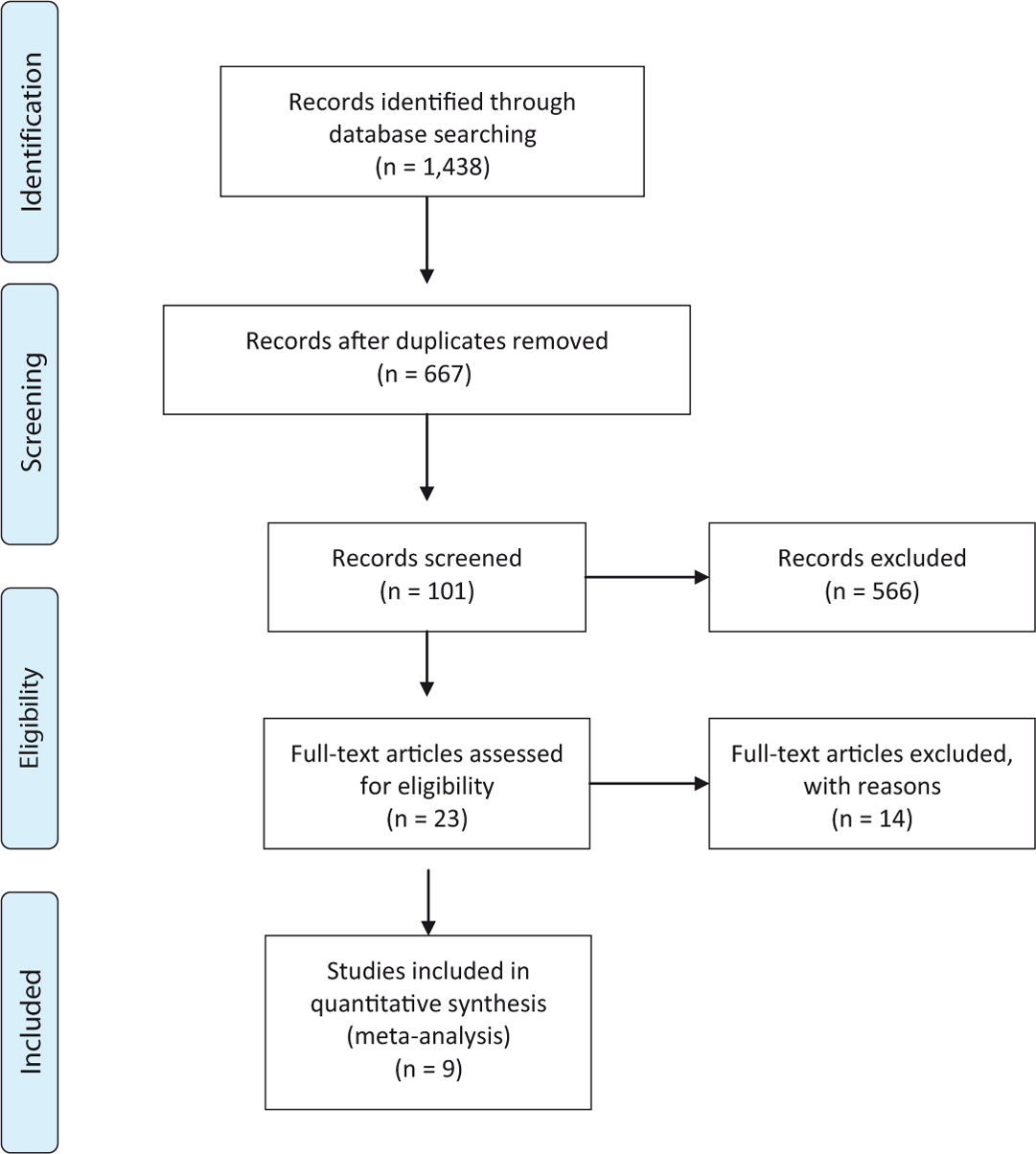
Figure 1: Literature search results.
Data collection
The authors manually extracted data from full scripts of selected articles using a standardized extraction form. The form includes general information about the study (author, year of published, study location and study period), study design (types of study design and control for threat to validity), sample characteristics (age, gender, race/ethnicity), types of intervention, outcome variables (measurement and parameter of outcome variable, effect size, p-value, 95% CI), statistical methods used in the studies, and appraisal of strengths and weakness of the studies. For studies having HIV patients as a subgroup of a larger study sample, the subgroup data were primarily used. Authors extracted and calculated the odd ratio (OR) and 95% CI to obtain the effect size of the intervention.25 To improve the consistency between the studies, for studies that employed more than one intervention arm, the OR based on mobile text message reminder intervention was compared to standard care. For longitudinal studies, data from the last measurement period was used to evaluate the sustainability of the intervention.
Data analysis
In order to assess heterogeneity between study results, the I-squared statistic was used to inform the method of meta-analysis. In the preliminary analysis, the I-squared values were 94.1% (heterogeneity chi-squared=136.41 (d.f.=8), p<0.001), suggesting study heterogeneity, and the need to use a random effects model of analysis to obtain overall effect sizes (ES). The random effects model assumes that the variability of ES across the studies is attributable not only to sample errors at the subject-level but to other unmeasured sources of error. This leads to a wider 95% CI for the ES using a random effect model.25,26 Funnel plots were evaluated for publication bias together with statistical tests (Egger’s and Begg’s tests). Stata 13 was used for analysis.
Study Outcomes: LTFU and Non-Attendance Rate
Given that studies were conducted with participants in HIV health care settings, the proportion of attendance at follow-up appointments was the primary outcome for the studies reviewed. In other words, non-attendance is used as a proxy measure for LTFU. The proportion of non-attendance is inherently a dichotomous variable. Therefore, the OR is used to calculate the effect size. Attendance was extracted from and confirmed by patients’ medical charts or clinic records. Attendance was counted as returning to care within a time frame as determined by study authors.
Results
Study Design and Types of SMS Reminders
All nine studies were conducted within the past 5 years, ranging from April 2010 to April 2015 (Table 1). Five RCTs and four before and after controlled studies were included in the final analysis. Before and after controlled studies were conducted at the clinic level to test the effectiveness of the mobile phone reminder intervention. Post-intervention groups were compared to pre-intervention groups, although the members in the two groups were different. Study settings were HIV clinics or hospitals from United States (US), Switzerland, United Kingdom (UK), Kenya, Cameroon, South Africa and Swaziland.
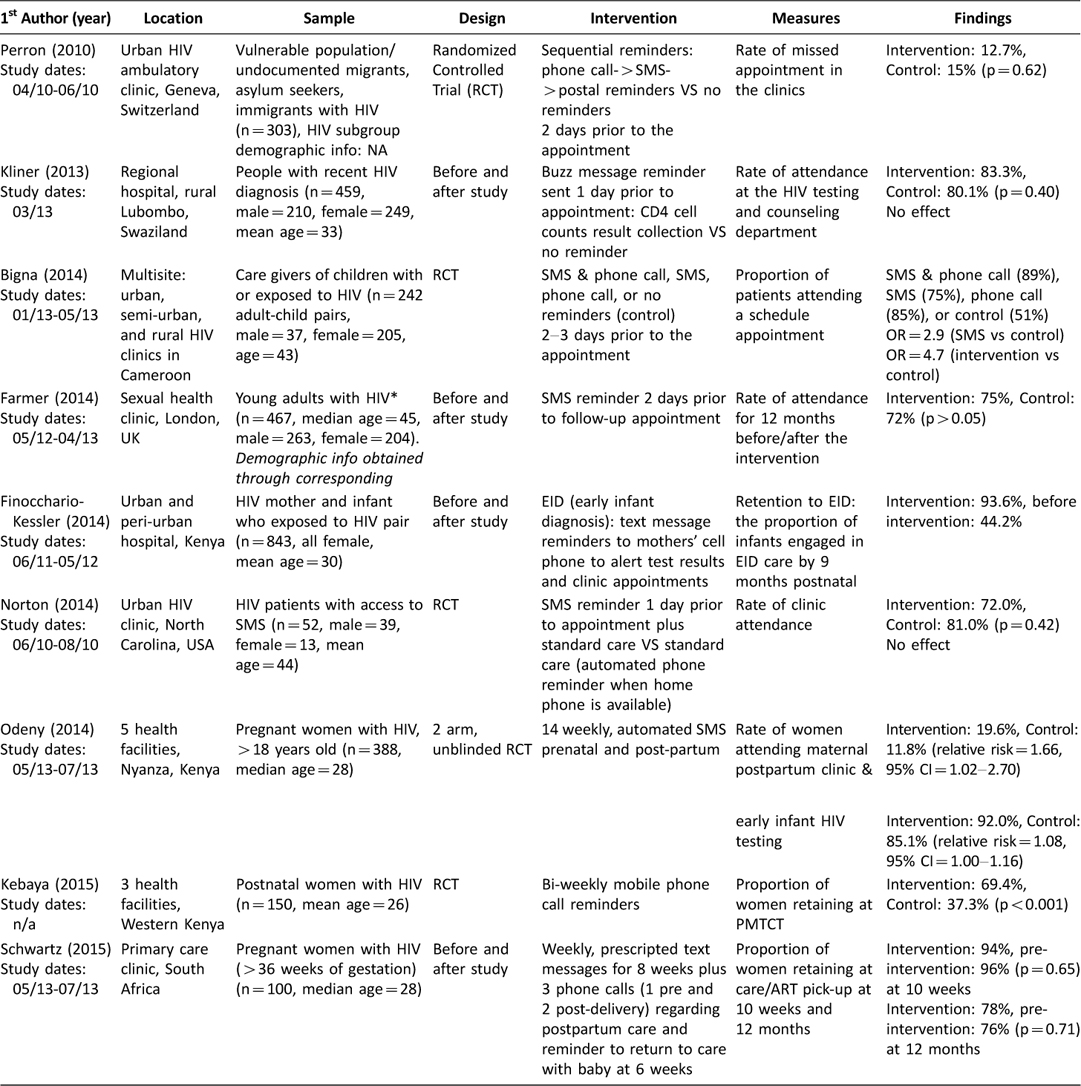
Table 1: Review of the Studies
The pooled sample size was a total of 3,004 participants. Study participants were adult patients with HIV or HIV-exposed babies paired with their mothers with HIV. For example, a study from Kenya implemented mobile phone reminders for HIV positive mothers to alert test results availability and clinic appointments for their babies exposed to HIV during birth. The unit of analysis for this study was the mother/caregiver and baby dyad. Sample characteristics are limited because one study27 did not provide any demographic information for the HIV sub-group, which was used in this review. Approximately 79.7% of the pooled sample were women and the median age of the sample was 34.6 years old.
Types of mobile phone reminders are divided into two categories: (1) appointment reminders, one or two days prior to the appointments using SMS; and (2) sequential reminders including mobile phone calls, and postal reminders after SMS reminders. The content of the reminders was not individualized. Examples of SMS from these studies were “come back to clinic” or “Remember: you have a doctor’s appointment tomorrow”. SMS were usually delivered once without confirmation of whether participants actually received the message or not.
Review of the studies
While all study interventions were automated text message reminders, Kliner et al. (2013) implemented ‘buzzing’ text message reminders at no cost to the patient and the clinic.14 The message received by the patient registered the hospital’s number as ‘go to hospital’ on participants’ mobile phones. However, the intervention did not increase return rates to the hospital to collect CD4 count results. The reminder maintained patient privacy, yet lacked specific reminder messages.
Norton and the colleagues used mobile phone text message reminders to PLWH to improve retention to care in the United States. The intervention group (n=25) received a text message and the control group (n=27) received the standard care procedure, an automated reminder phone call to a landline. The study had a high participant refusal rate (45%) at screening and a high attrition rate (28%) in the intervention group. This resulted in small sample size and low statistical power; this RCT did not detect efficacy of the mobile text message reminder to improve retention to care.28
The efficacy of mobile phone reminders was established among patients attending primary care clinics in Geneva27 and a sexual health clinic in London.29 Overall missed appointment rates dropped by four percent (p<0.005) in the clinic after the intervention. Male sexual health clinic attendants were more likely to return to care than females and PLWH (10%, p<0.05).29 For the total sample, the missed appointment rate was lower (7.8%) among the intervention group, compared to 11.4% (p<0.005) in the usual care group.27 However, when sub-group analysis was performed with PLWH, the intervention did not improve clinic attendance.27,29
Five studies used mobile phone reminders to target mothers with HIV to improve retention to a prevention of mother to child transmission program (PMTCT) or to follow up with babies who were exposed to HIV during birth.30–34 All five of the studies are from Africa and targeted retention to postnatal care and early diagnosis of HIV of the babies exposed to HIV. Four studies concluded that mobile phone reminders significantly improved the outcomes (See Table 1, Figure 4). Schwartz and colleagues’ before and after controlled study did not find that weekly mobile phone reminders significantly improved postnatal women’s returning to care.34
Based on our systematic review, four studies were excluded from the meta-analysis because they enrolled participants at risk for HIV, but who did not have HIV. Three studies35–37 were similar to each other in study design, settings and population and were conducted in large, urban sexual health clinics in developed countries (Table 2). The samples were drawn from populations at high risk for HIV based on their sexual health history, and mainly consisted of young men who had sex with men. Odeny et al. (2012) conducted a two-arm RCT in Kenya that we also excluded because the study targeted adult males who underwent circumcision as a measure of HIV prevention. The intervention group received daily informative text messages on post-circumcision care and reminders to return for follow-up appointment. Although the study result did not reach statistical significance, the intervention group was more likely to return to care (RR=1.09, 95% CI=1.00–1.20, P<0.05) compared to those men who didn’t receive an SMS message.13
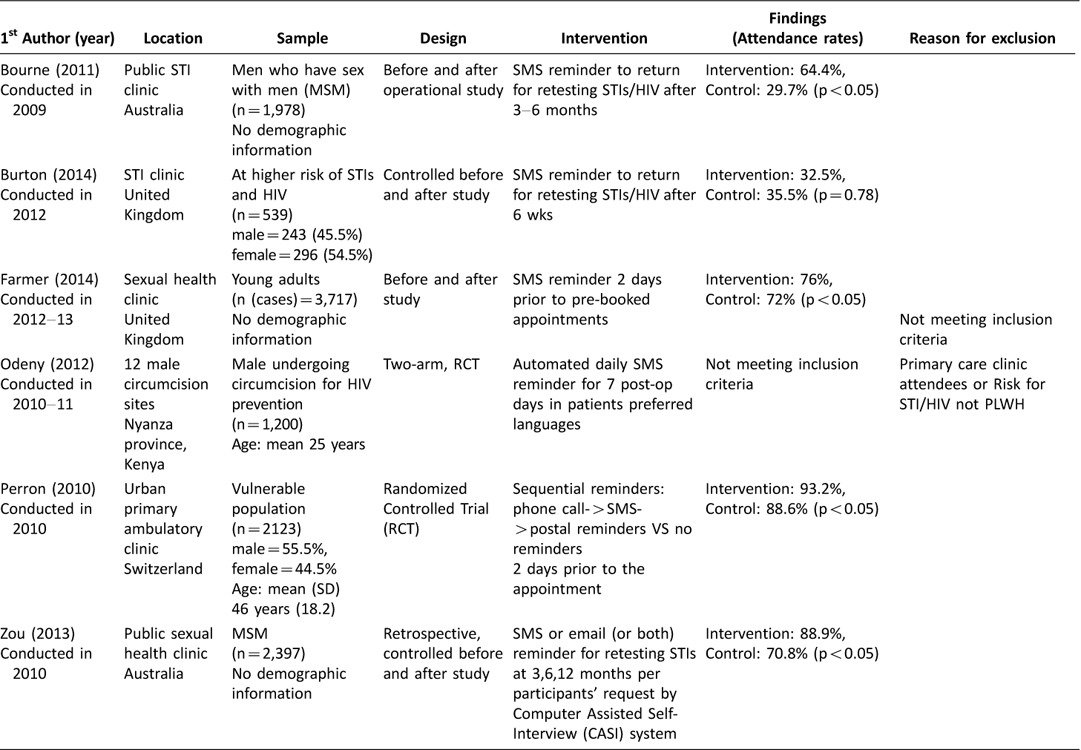
Table 2: Review of excluded studies with reasons
The Effectiveness of Mobile Phone Reminders
A random effects model was used to present the overall effect of the mobile phone reminder intervention among PLWH in 9 studies (Figure 2). Mobile phone reminders improved clinic attendance at follow-up appointments compared to usual care among PLWH (pooled OR=2.04, 95% CI: 0.97–4.27), however, this result was not statistically significant.
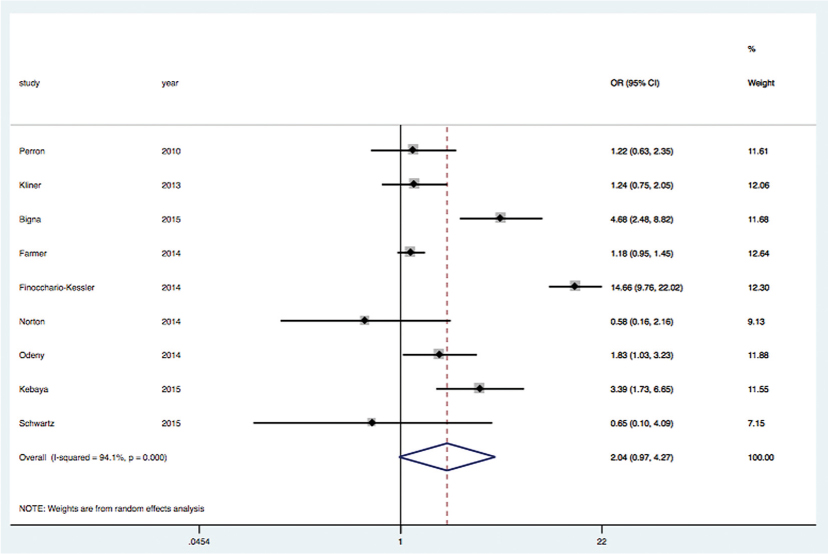
Figure 2: Forest plot for 9 studies of Mobile Phone Reminders.
Figure 3 shows a funnel plot of the nine studies. There is no evidence of publication bias but a small study effect exists (Eger’s p=0.647, Begg’s p=0.835).
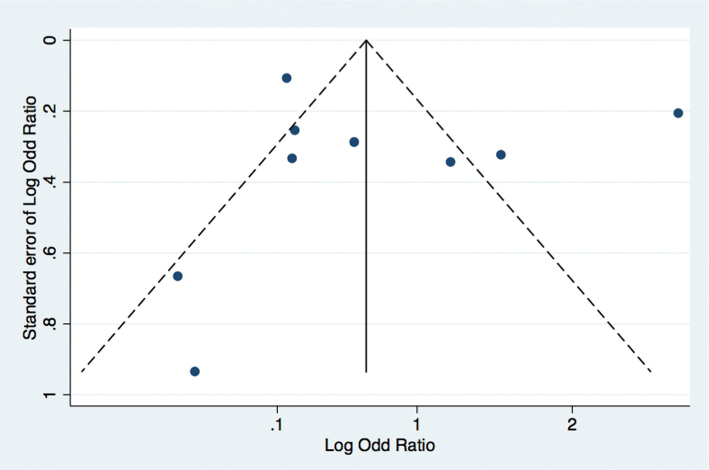
Figure 3: Funnel plot with pseudo 95% confidence limits.
Sub-group analysis
A sub-group analysis was conducted with the six studies (four RCTs and two before and after controlled studies) from Africa (n=2,182). Ninety percent of the pooled sample were women, because five out the six studies were carried out at PMTCT or post-natal clinic settings. PLWH who received mobile phone reminders were about three times more likely to return to care than those in usual care (pooled OR=2.92, 95% CI: 1.13–7.53) (see Figure 4). The analysis with three studies (two RCTs and one before and after study) from UK, U.S., and Switzerland (n=822) did not show a statistically significant difference between groups who received mobile phone reminders and those who received standard care (pooled OR=1.16, 95% CI: 0.95–1.42).
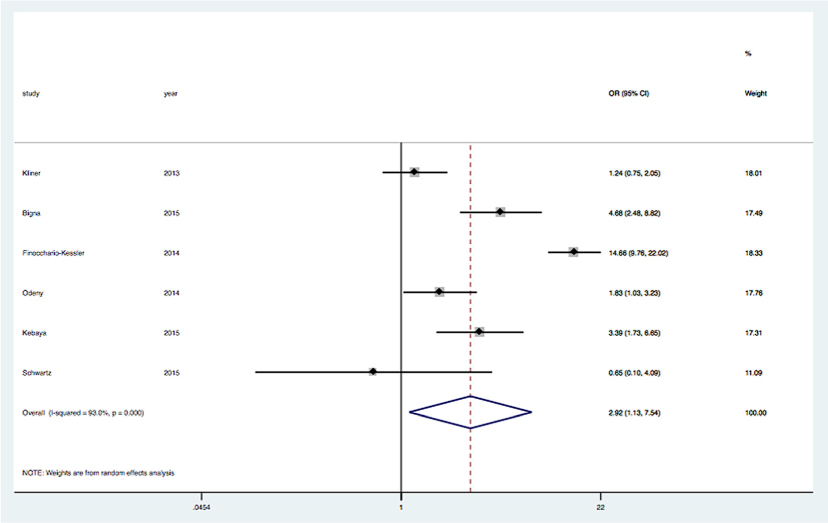
Figure 4: Forest plot for 6 studies from Africa.
Another subgroup analysis was conducted after excluding the 4 before and after studies (Figure 5). The pooled sample for the five RCTs is 1,135.27,28,31,33,38 Mobile phone reminders significantly improved clinic attendance compared to usual care (pooled OR=2.04, 95% CI: 1.11–3.74).
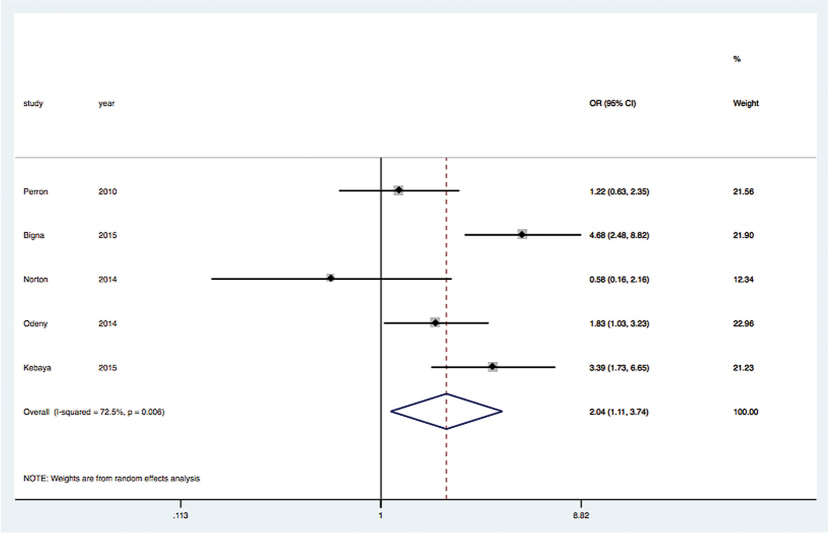
Figure 5: Forest plot of Randomized Controlled Studies
Discussion
This is the first systematic review and meta-analysis to assess the efficacy of mobile phone reminders to improve retention to care among PLWH in both high- and low-income countries. We found that PLWH who received mobile phone reminders for their follow-up appointments were two times more likely to return to care than those who didn’t receive reminders; however, this estimate was not statistically significant. Our sub-group analysis of 5 RCTs showed a significant effect of mobile phone reminders and 6 studies in Africa found that PLWH, mostly women with HIV who received mobile phone reminders were three times more likely to return to care than those who received no reminders, and these findings were statistically significant.
Mobile phone reminders are an effective intervention in resource-limited settings. Our study findings are consistent with the Cochrane review of mobile phone reminders on follow-up appointments among a general population. The review included four RCTs conducted in various health care settings ranging from health promotion centers, primary care clinics, and ENT clinics from four mid- to high-income countries. The review concluded that mobile phone reminders had a low to moderate effect in improving clinic attendance, based on three RCTs of moderate quality (RR: 1.10; 95% CI=1.03, 1.17).18
Mobile phone reminders address ‘patient forgetfulness’, and may mitigate LTFU by providing simple reminders using mobile phones. However, LTFU, or poor retention to care, is multi-factorial, and these reasons differ depending on whether PLWH live in high- or low-income countries. In Swaziland, patients who were eligible to start ART tended to return for follow-up because of the symptoms they experienced.39 In Ethiopia, Bezabhe and colleagues used qualitative interviews among 24 patients and identified three facilitators of retention to care —disclosure of HIV status, social support, and use of reminder aids.15 Therefore, mobile phone reminders will be more effective when they address multifaceted issues, such as signs and symptoms that prompt a clinic visit.
None of the reviewed studies reported use of theoretical frameworks to guide the intervention. Despite usefulness of theory to guide interventions, research study design, and data collection and analysis, studies often underestimate how theory can increase understanding of why an effect is occurring or not.40 Coomes et al. proposed a conceptual framework for ‘integrating the communication functionality of SMS with important psychosocial factors that could mediate the impact of SMS communication on health outcomes’.22 This model suggests that the SMS intervention is a helpful tool to improve healthcare quality, as well as patient health outcomes, when SMS is interactive, when content is personalized, and when timing of the SMS is factored into to the intervention.22 Similarly, Finitsis and colleagues’ meta-analysis found that SMS interventions had larger effects when messages were sent less frequently than daily, allowed for bidirectional communication, and were personalized messages tailored to patients’ needs.23
There are several limitations to the present analysis. First, the analysis was not limited to RCTs, which limits our ability to state that the SMS intervention, in and of itself, improves retention to HIV care. Second, the sample size (n=9) is small and studies were heterogeneous. Finally, every study required mobile phone ownership in order to be eligible for study participation. Thus, findings are not generalizable to the non-mobile phone owners, who may be the most marginalized and most likely to be non-adherent to clinic visits. It is important to note that the pooled analysis is mainly based on women with HIV from resource-limited settings. Therefore, our findings may not generalize to men with HIV or PLWH in high-income countries.
There are several studies from South Africa, Kenya, Swaziland, Mozambique, Malawi and United States that are currently testing mobile phone reminders on retention to HIV care.41–46 A two-armed RCT in the US is currently testing SMS reminders boosted with informational, supportive, and motivational messages on retention to care and virological suppression of HIV. This study is based on behavioral theory and it testing cost-effectiveness of the intervention.44 All of these studies will add to the body of literature on SMS on retention to care.
To date, most research on mobile technologies in resource-limited settings has been in the area of HIV management. In addition, one study from Bangladesh tests a mobile phone intervention to improve type 2 diabetes management in an urban setting.47 SMS reminders are also being tested in Nigeria to manage hypertension.48 Although some studies are being done in resource-limited settings on the efficacy of mobile technologies in chronic disease management, the majority of this work has been limited to developed countries.49,50 More research is needed from resource-limited settings to test mobile technologies for conditions beyond HIV.
Conclusion
Sub-optimal adherence to HIV care can lead to ART drug resistance, and this has become a threat to the health of PLWH.23,51 Mobile phone reminders are a relatively new and innovative approach in HIV care, but the body of evidence to date is inconclusive about the impact of SMS on clinic attendance and HIV health outcomes across settings. We found a strong effect of mobile phone reminders to improve PLWH’s attendance to care in resource limited settings, mostly among women with young infants.
With the ubiquitous ownership of mobile phones globally, including among people living in low-income countries, mobile phone reminders to return to clinic for care are feasible. Future studies should examine the impact of incentivized SMS reminder interventions on access to health services and improved HIV health outcomes. Messages should be designed to allow for bidirectional conversations, be tailored for individual needs and should serve as a bridge to other healthcare and social support resources. The ultimate goal of SMS reminders is not only to improve retention to HIV care, but to improve the quality of life of people living with HIV around the world.
References
1. WHO. Global Health Observatory (GHO), HIV/AIDS: global situation and trends. http://www.who.int/gho/hiv/en/, Accessed February 2nd 2014.
2. UNAIDS. Regional Fact Sheet http://www.unaids.org/sites/default/files/en/media/unaids/contentassets/documents/epidemiology/2012/gr2012/20121120_FactSheet_Global_en.pdf, Accessed February 2012.
3. Rosen S, Fox MP. Retention in HIV care between testing and treatment in sub-Saharan Africa: a systematic review. PLoS Med 2011 Jul;8(7):e1001056. ![]()
4. International Telecommunication Union. The World in 2013: the Facts and Figures. 2013; Available at: http://www.itu.int/en/ITU-D/Statistics/Pages/facts/default.aspx, Accessed March 23, 2014.
5. Aranda-Jan CB, Mohutsiwa-Dibe N, Loukanova S. Systematic review on what works, what does not work and why of implementation of mobile health (mHealth) projects in Africa. BMC Public Health 2014 Feb 21;14:188. ![]()
6. Berg MB, Safren SA, Mimiaga MJ, Grasso C, Boswell S, Mayer KH. Non adherence to medical appointments is associated with increased plasma HIV RNA and decreased CD4 cell counts in a community-based HIV primary care clinic. AIDS Care 2005 Oct;17(7):902–7. ![]()
7. Gardner EM, McLees MP, Steiner JF, Del Rio C, Burman WJ. The spectrum of engagement in HIV care and its relevance to test-and-treat strategies for prevention of HIV infection. Clin Infect Dis 2011 Mar 15;52(6):793–800. ![]()
8. Giordano TP, Gifford AL, White AC, Jr, Suarez-Almazor ME, Rabeneck L, Hartman C, et al. Retention in care: a challenge to survival with HIV infection. Clin Infect Dis 2007 Jun 1;44(11):1493–9. ![]()
9. Marks G, Gardner LI, Craw J, Crepaz N. Entry and retention in medical care among HIV-diagnosed persons: a meta-analysis. AIDS 2010 Nov 13;24(17):2665–78. ![]()
10. Losina E, Toure H, Uhler LM, Anglaret X, Paltiel AD, Balestre E, et al. Cost-effectiveness of preventing loss to follow-up in HIV treatment programs: a Cote d’Ivoire appraisal. PLoS Med 2009 Oct;6(10):e1000173. ![]()
11. Chi BH, Yiannoutsos CT, Westfall AO, Newman JE, Zhou J, Cesar C, et al.Universal definition of loss to follow-up in HIV treatment programs: a statistical analysis of 111 facilities in Africa, Asia, and Latin America. PLoS Med 2011 Oct;8(10):e1001111. ![]()
12. Bourne C, Knight V, Guy R, Wand H, Lu H, McNulty A. Short message service reminder intervention doubles sexually transmitted infection/HIV re-testing rates among men who have sex with men. Sex Transm Infect 2011 Apr;87(3):229–31. ![]()
13. Odeny TA, Bailey RC, Bukusi EA, Simoni JM, Tapia KA, Yuhas K, et al. Text messaging to improve attendance at post-operative clinic visits after adult male circumcision for HIV prevention: a randomized controlled trial. PLoS One 2012;7(9):e43832. ![]()
14. Kliner M, Knight A, Mamvura C, Wright J, Walley J. Using no-cost mobile phone reminders to improve attendance for HIV test results: a pilot study in rural Swaziland. Infect Dis Poverty 2013 Jun 14;2(1):12-9957-2-12. ![]()
15. Bezabhe WM, Chalmers L, Bereznicki LR, Peterson GM, Bimirew MA, Kassie DM. Barriers and facilitators of adherence to antiretroviral drug therapy and retention in care among adult HIV-positive patients: a qualitative study from Ethiopia. PLoS One 2014 May 14;9(5):e97353. ![]()
16. Dalal RP, Macphail C, Mqhayi M, Wing J, Feldman C, Chersich MF, et al. Characteristics and outcomes of adult patients lost to follow-up at an antiretroviral treatment clinic in Johannesburg, South Africa. J Acquir Immune Defic Syndr 2008 Jan 1;47(1):101–7. ![]()
17. Perron NJ, Dao MD, Kossovsky MP, Miserez V, Chuard C, Calmy A, et al. Reduction of missed appointments at an urban primary care clinic: a randomised controlled study. BMC Family Practice 2010 OCT 25 2010;11:79. ![]()
18. Car J, Gurol-Urganci I, de Jongh T, Vodopivec-Jamsek V, Atun R. Mobile phone messaging reminders for attendance at healthcare appointments. Cochrane Database Syst Rev 2012 Jul 11;7:CD007458. ![]()
19. Higa DH, Marks G, Crepaz N, Liau A, Lyles CM. Interventions to improve retention in HIV primary care: a systematic review of U.S. studies. Curr HIV/AIDS Rep 2012 Dec;9(4):313–25. ![]()
20. Thornton RL. The Demand for, and Impact of, Learning HIV Status. Am Econ Rev 2008 Dec 1;98(5):1829–63. ![]()
21. Kunutsor S, Walley J, Katabira E, Muchuro S, Balidawa H, Namagala E, et al. Using Mobile Phones to Improve Clinic Attendance Amongst an Antiretroviral Treatment Cohort in Rural Uganda: A Cross-sectional and Prospective Study. Aids and Behavior 2010 Dec;14(6):1347–52. ![]()
22. Coomes CM, Lewis MA, Uhrig JD, Furberg RD, Harris JL, Bann CM. Beyond reminders: a conceptual framework for using short message service to promote prevention and improve healthcare quality and clinical outcomes for people living with HIV. AIDS Care 2012;24(3):348–57. ![]()
23. Finitsis DJ, Pellowski JA, Johnson BT. Text message intervention designs to promote adherence to antiretroviral therapy (ART): a meta-analysis of randomized controlled trials. PLoS One 2014 Feb 5;9(2):e88166. ![]()
24. Moher D, Liberati A, Tetzlaff J, Altman DG, PRISMA Group. Preferred reporting items for systematic reviews and meta-analyses: the PRISMA statement. PLoS Med 2009 Jul 21;6(7):e1000097. ![]()
25. Lipsey M, Wilson D. Practical Meta-Analysis. Thousand Oaks, California: Sage publications, Inc; 2001.
26. Higgins JP, Thompson SG, Deeks JJ, Altman DG. Measuring inconsistency in meta-analyses. BMJ 2003 Sep 6;327(7414):557–60. ![]()
27. Perron NJ, Dao MD, Kossovsky MP, Miserez V, Chuard C, Calmy A, et al. Reduction of missed appointments at an urban primary care clinic: a randomised controlled study. BMC Fam Pract 2010 Oct 25;11:79-2296-11-79. ![]()
28. Norton BL, Person AK, Castillo C, Pastrana C, Subramanian M, Stout JE. Barriers to using text message appointment reminders in an HIV clinic. Telemed J E Health 2014 Jan;20(1):86–9. ![]()
29. Farmer T, Brook G, McSorley J, Murphy S, Mohamed A. Using short message service text reminders to reduce ‘did not attend’ rates in sexual health and HIV appointment clinics. Int J STD AIDS 2014 Mar;25(4):289–93. ![]()
30. Bigna JJR, Noubiap JJN, Kouanfack C, Plottel CS, Koulla-Shiro S. Effect of mobile phone reminders on follow-up medical care of children exposed to or infected with HIV in Cameroon (MORE CARE): a multicentre, single-blind, factorial, randomised controlled trial. The Lancet Infectious Diseases 2014 7;14(7):600–8. ![]()
31. Kebaya L, Nduati R, Wamalwa D, Kariuki N, Bashir A. PO-0260a Efficacy Of Mobile Phone Use On Adherence To Nevirapine Prophylaxis And Retention In Care Among The Hiv-exposed Infants In Pmtct: A Randomised Controlled Trial. Archives of Disease in Childhood 2014 October 01;99(Suppl 2):A329. ![]()
32. Finocchario-Kessler S, Gautney BJ, Khamadi S, Okoth V, Goggin K, Spinler JK, et al. If you text them, they will come: using the HIV infant tracking system to improve early infant diagnosis quality and retention in Kenya. AIDS 2014 Jul;28 Suppl 3:S313–21. ![]()
33. Odeny TA, Bukusi EA, Cohen CR, Yuhas K, Camlin CS, McClelland RS. Texting improves testing: a randomized trial of two-way SMS to increase postpartum prevention of mother-to-child transmission retention and infant HIV testing. AIDS 2014 Sep 24;28(15):2307–12. ![]()
34. Schwartz SR, Clouse K, Yende N, Van Rie A, Bassett J, Ratshefola M, et al. Acceptability and Feasibility of a Mobile Phone-Based Case Management Intervention to Retain Mothers and Infants from an Option B+ Program in Postpartum HIV Care. Matern Child Health J 2015 Sep;19(9):2029–37. ![]()
35. Zou H, Fairley CK, Guy R, Bilardi J, Bradshaw CS, Garland SM, et al. Automated, Computer Generated Reminders and Increased Detection of Gonorrhoea, Chlamydia and Syphilis in Men Who Have Sex with Men. Plos One 2013 Apr 17;8(4):e61972. ![]()
36. Burton J, Brook G, McSorley J, Murphy S. The utility of short message service (SMS) texts to remind patients at higher risk of STIs and HIV to reattend for testing: a controlled before and after study. Sex Transm Infect 2014 Feb;90(1):11–3. ![]()
37. Bourne C, Knight V, Guy R, Wand H, Lu H, McNulty A. Short message service reminder intervention doubles sexually transmitted infection/HIV re-testing rates among men who have sex with men. Sex Transm Infect 2011 Apr;87(3):229–31. ![]()
38. Bigna JJ, Kouanfack C, Noubiap JJ, Plottel CS, Koulla-Shiro S. A randomized blinded controlled trial of mobile phone reminders on the follow-up medical care of HIV-exposed and HIV-infected children in Cameroon: study protocol (MORE CARE). Trials 2013 Sep 25;14:313-6215-14-313. ![]()
39. Kliner M, Knight A, Mamvura C, Wright J, Walley J. Using no-cost mobile phone reminders to improve attendance for HIV test results: a pilot study in rural Swaziland. Infect Dis Poverty 2013 Jun 14;2(1):12-9957-2-12. ![]()
40. Reeves S, Kuper A, Hodges BD. Qualitative research methodologies: ethnography. BMJ 2008 Aug 7;337:a1020. ![]()
41. Bassett IV, Giddy J, Chaisson CE, Ross D, Bogart LM, Coleman SM, et al. A randomized trial to optimize HIV/TB care in South Africa: design of the Sizanani trial. BMC Infect Dis 2013 Aug 26;13:390-2334-13-390. ![]()
42. Van der Kop ML, Ojakaa DI, Patel A, Thabane L, Kinagwi K, Ekstrom AM, et al. The effect of weekly short message service communication on patient retention in care in the first year after HIV diagnosis: study protocol for a randomised controlled trial (WelTel Retain). BMJ Open 2013 Jun 20;3(6):10.1136/bmjopen-2013-003155. ![]()
43. McNairy ML, Gachuhi AB, Lamb MR, Nuwagaba-Biribonwoha H, Burke S, Ehrenkranz P, et al. The Link4Health study to evaluate the effectiveness of a combination intervention strategy for linkage to and retention in HIV care in Swaziland: protocol for a cluster randomized trial. Implement Sci 2015 Jul 19;10:101-015-0291-4. ![]()
44. Christopoulos KA, Riley ED, Tulsky J, Carrico AW, Moskowitz JT, Wilson L, et al. A text messaging intervention to improve retention in care and virologic suppression in a U.S. urban safety-net HIV clinic: study protocol for the Connect4Care (C4C) randomized controlled trial. BMC Infect Dis 2014 Dec 31;14:718-014-0718-6. ![]()
45. Elul B, Lahuerta M, Abacassamo F, Lamb MR, Ahoua L, McNairy ML, et al. A combination strategy for enhancing linkage to and retention in HIV care among adults newly diagnosed with HIV in Mozambique: study protocol for a site-randomized implementation science study. BMC Infect Dis 2014 Oct 15;14:549-014-0549-5. ![]()
46. Mwapasa V, Pro G, Chinkhumba J, Mukaka M, Kobayashi E, Stuart A, et al. Mother-infant pair clinic and SMS messaging as innovative strategies for improving access to and retention in eMTCT care and Option B+ in Malawi: a cluster randomized control trial (the PRIME study). J Acquir Immune Defic Syndr 2014 Nov 1;67 Suppl 2:S120–4. ![]()
47. Islam SM, Lechner A, Ferrari U, et al. Mobile phone intervention for increasing adherence to treatment for type 2 diabetes in an urban area of Bangladesh: Protocol for a randomized controlled trial. BMC Health Serv Res. 2014;14:586-014-0586-1. ![]()
48. Owolabi MO, Akinyemi RO, Gebregziabher M, et al. Randomized controlled trial of a multipronged intervention to improve blood pressure control among stroke survivors in Nigeria. Int J Stroke 2014;9(8):1109–16. ![]()
49. Thakkar J, Kurup R, Laba TL, et al. Mobile telephone text messaging for medication adherence in chronic disease: A meta-analysis. JAMA Intern Med 2016;176(3):340–9. ![]()
50. de Jongh T, Gurol-Urganci I, Vodopivec-Jamsek V, Car J, Atun R. Mobile phone messaging for facilitating self-management of long-term illnesses. Cochrane Database Syst Rev 2012;12:CD007459. ![]()
51. Berg MB, Safren SA, Mimiaga MJ, Grasso C, Boswell S, Mayer KH. Nonadherence to medical appointments is associated with increased plasma HIV RNA and decreased CD4 cell counts in a community-based HIV primary care clinic. AIDS Care 2005 Oct;17(7):902–7. ![]()

